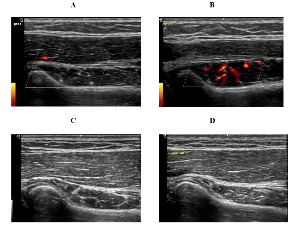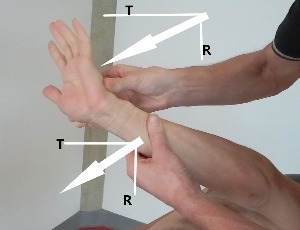Loading
Journal of Physical Medicine and Rehabilitation
ISSN: 2690-0297

2022
Volume 4, Issue 2, p28-57
Articles published in this issue are Open Access and licensed under Creative Commons Attribution License (CC BY NC) where the readers can reuse, download, distribute the article in whole or part by mentioning proper credits to the authors.
Manual Therapy Improves Immediate Blood Flow and Tissue Fiber Alignment of the Forearm Extensors
Timothy E. Speicher, Noelle M. Selkow, Aric J. Warren
It is well established that lateral elbow pain and dysfunction is a common pathology in general and sport populations [1-3]. Lateral elbow pain has been termed tennis elbow, epicondylitis, elbow tendinosis, elbow tendinopathy, but currently, the term lateral epicondylalgia (LE) encompasses the spectrum of degeneration and
J Phys Med Rehabil, 2022, Volume 4, Issue 2, p28-36 | DOI: 10.33696/rehabilitation.4.029
The Essential Elements of the PNF-concept, an Educational Narrative
Fred Smedes
The term Proprioceptive Neuromuscular Facilitation (PNF) was introduced in the 1950s by Dr. Kabat and Mrs. Knott. From the mid-1950s the PNF-concept has been in a progressive development clarifying the use of techniques, performances and clinical applications. The concept of PNF was originally developed by Dr. Kabat and Mrs. Knott for rehabilitation purposes. The International PNF Association (IPNFA) consider themselves to be the official successor of Dr. Kabat and Mrs. Knott.
J Phys Med Rehabil, 2022, Volume 4, Issue 2, p37-48 | DOI: 10.33696/rehabilitation.4.030
Radiographic Features of Lateralized Reverse Shoulder Arthroplasty in Osteoarthritis
Giovanni Merolla
RSA is a worldwide treatment to manage pain and improve shoulder function in patients with advanced gleno-humeral osteoarthritis. The main efforts of researchers were directed to address glenoid replacement, using devices that would preserve glenoid bone stock and ensure prosthesis stability.
J Phys Med Rehabil, 2022, Volume 4, Issue 2, p49-57 | DOI: 10.33696/rehabilitation.4.031
Recommended Articles
Introducing the New Journal in Physical Medicine and Rehabilitation
It gives us great pleasure to introduce readers with our international peer-reviewed, open access journal. Journal of Physical Medicine and Rehabilitation is devoted to publish original research, reviews, and clinical reports on key areas of Physical Medicine and Rehabilitation and related fields.
Motor Imagery in Facial Palsy Rehabilitation
Intentional facial expression of emotion named facial mimic is critical to healthy social interactions. Psychological and functional implications of the facial paralysis present a devastating management problem to patients afflicted because their face have an important challenge of facial muscles that are fundamental also for affective communication.
Modern Rehabilitation Strategies of Post-Stroke Motor Disfunctions: Functional Electrical Stimulation and Biofeedback-Stabilometric Postural Training
More than 80% of patients after a stroke have limited daily activity due to a complex polymorphic motor deficiency of various nature and severity, which leads to postural disorders (PD) [1]. Because of paresis, develops different changes in the musculoskeletal system (MSS) such as PD, restrictions of movements in the joints, impaired
The Consideration of Endometriosis in Women with Persistent Gastrointestinal Symptoms and a Novel Neuromusculoskeletal Treatment Approach
Endometriosis is a chronic, hormone-dependent, inflammatory disease, characterized by the presence and growth of endometrial tissue outside the uterine cavity and it is associated with chronic pelvic pain and infertility. Worldwide, approximately 176 million women between the ages of 15 and 49 are affected by endometriosis. Endometriosis is a complex disease that induces a chronic inflammatory process and can be challenging to treat. Chronic pelvic pain syndrome (CPPS) is defined as pelvic pain lasting greater than three to six months that is not solely related to menstruation, sexual activity or bowel movements.
Risks and Countermeasures for the Musculoskeletal systems in the Extreme Environment of Aviators and Astronauts
Resistive Exercise in Astronauts on Prolonged Spaceflights provides partial Protection against Spaceflight-induced Bone Loss showed very promising data on measures that can be employed to preserve the bone and muscular health of astronauts. The value of the information from these measures of bone and muscular health is how the
Bronchoscopic Lung Volume Reduction Operation and Pulmonary Rehabilitation
The main symptom in Chronic Obstructive Pulmonary Disease (COPD) is shortness of breath. Shortness of breath occurs especially with exercise and progresses over the years despite all medical treatments. One of the main mechanisms by which this symptom occurs is hyperinflation in the lungs [1].
Emerging Nanogenerators for Rehabilitation Monitoring and Information Interaction
Patients with limb motor dysfunction caused by trauma and stroke have poor mobility to take care of themselves, which seriously affects the quality of life of them. Through reasonable rehabilitation training, the damaged motor function can be relieved to a certain extent. In the rehabilitation training, the monitoring of limb movement can reflect the recovery state of patients’ physiological function and make a systematic evaluation on the rehabilitation training effect of patients,
Rehabilitation Providers’ Experiences with Rapid Telerehabilitation Implementation During the COVID-19 Pandemic in the United States
Telehealth has been around since the 1960s as a healthcare delivery modality, though it did not gain widespread acceptance as a viable and reliable clinical tool until the late 1990s, when digital imaging and high speed, high bandwidth telecommunications technology became widely available [1]. Historical boundaries to its acceptance and
A Neuromuscular Integration Approach to the Rehabilitation of Forward Head and Rounded Shoulder Posture: Systematic Review of Literature
Forward head posture (FHP) and rounded shoulder posture (RSP) are common postural misalignments caused by muscular imbalance that lead to a variety of pain patterns in the neck and shoulder [1,2]. FHP prevalence ranges from 61% to 85% and is associated with RSP [3-7]. RSP prevalence ranges from 66% to 78% [3,5,7]. Importantly,
An Extended Interpretation and Practice of Rehabilitation
Rehabilitation is an essential part of Medical and Health Care. Rehabilitation helps people of all ages to be independent, particularly after health hazards: which for children and young people are related to congenital anomalies, injuries and acute illnesses; for elderly people, the chronic diseases and aging itself could be the culprit.
Integrating Neurology and Psychiatry throughout Educational Curricula for Healthcare Professionals
We recently reviewed the scientific literature linking dopamine agonist pharmacotherapy for neurological disorders to the development of impulsive and compulsive spectrum disorders (ICSDs).
Resilience in Rheumatic and Musculoskeletal Diseases
Along the last decade, likewise in other fields, the concept of resilience has been gaining relevance in medicine and psychology where, although many different definitions have been proposed, it can be briefly described as the skill to positively cope with stressful life events [1].
Radiographic Features of Lateralized Reverse Shoulder Arthroplasty in Osteoarthritis
RSA is a worldwide treatment to manage pain and improve shoulder function in patients with advanced gleno-humeral osteoarthritis. The main efforts of researchers were directed to address glenoid replacement, using devices that would preserve glenoid bone stock and ensure prosthesis stability.
Immunologic Implications for Stroke Recovery: Unveiling the Role of the Immune System in Pathogenesis, Neurorepair, and Rehabilitation
Stroke is a debilitating neurologic condition characterized by an interruption or complete blockage of blood flow to certain areas of the brain. While the primary injury occurs at the time of the initial ischemic event or hemorrhage, secondary injury mechanisms contribute to neuroinflammation, disruption of the blood-brain barrier (BBB), excitotoxicity, and cerebral edema in the days and hours after stroke.
Non-Invasive Pelvic Floor Rehabilitation in Cancer Population
The pelvic floor (PF) is a complex network of muscles and ligaments that serves as a crucial structural support for various pelvic organs, including the bladder, urethra, prostate, vagina, uterus, anus, and rectum, while also indirectly supporting intra-abdominal contents. It forms a hammock-like supportive layer embedded from the pubic bone to the sacrum/coccyx and ischial tuberosities.
About Scientific Archives
Scientific Archives is a global publisher initiated with the mission of ensuring equal opportunity for accessing science to research community all over the world. Spreading research findings with great relevance to all channels without any barrier is our goal. We want to overcome the challenges of Open Access with ensured quality and transparency.
